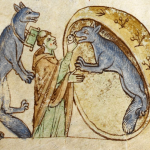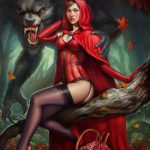The first time a werewolf appeared in the television series was in the Seventh Doctor serial The Greatest Show in the Galaxy (1988). A wolf-man appears in the 1986 Sixth Doctor story Mindwarp, and the primords in the 1970 Third Doctor story Inferno are also lupine in appearance, but in both cases these are induced mutations rather than people who switched between human and wolf forms. They also appeared in the 2006 Tenth Doctor episode Tooth and Claw.
 Buffy the Vampire Slayer
Buffy the Vampire Slayer
Joss Whedon’s TV program featured a likeable young werewolf, Daniel ‘Oz’ Osbourne, who often assisted Buffy in fighting evil while in human form, and had himself locked in a cage during the full moon.
Discworld
Werwolves on the Discworld can be both born and infected by a bite. A true bimorph can change between human-like and wolf-like shape at will (but have to take care of their clothes, which are not included in the transformation), but have to change during full moon. The descriptions are not entirely consistent if they change to wolf-like shape only when exposed to the light of the full moon, or in nights in the week around full moon. While they can pass as human, wolves will recognize a werewolf, presumably through smell, although there has been mentioned that there is something about their eyes, occupation and method of walking that contain telltail signs that the person is a werewolf. They have at all times a superhumanly keen sense of smell. Especially while in lupine shape or a short time after returning from it, it is described as Synaesthesia of "seeing" smells as colours. Werewolves can only be killed with fire or silver. Silver burns them (similar to a bad sunburn) when they touch it. A werewolf in lupine shape does retain their intelligence, but when they stay changed for too long thinking becomes difficult, and instincts may take over. A silver collar is both painful and makes thinking difficult.
Harry Potter
In J.K. Rowling’s series, werewolves are cursed to turn into vicious wolves in the light of the full moon, and are dangerous only to humans, whom they will attack whenever possible.
J.K. Rowling uses a werewolf named Remus Lupin as a metaphor for intolerance and people’s reactions to illness and disability. Though distrusted in his world, Lupin is depicted as a kind person and as the only competent Defense Against the Dark Arts teacher. As a complete contrast to the Lupin character, Rowling also introduced the character Fenrir Greyback who not only embraces his werewolf heritage, but revels in his animality even when in his human form. The Potter books, while showing the intense threat the humans transformed to bloodthirsty monsters pose to the population, essentially use werewolves as a metaphor for marginalised groups who have been discriminated against in modern society.
Middle-earth
J. R. R. Tolkien’s Middle-earth legendarium also features werewolves. Werewolves in Middle-earth are not shapeshifters, but evil spirits in wolf form.
The Talisman (1983)
In this novel (co-written by Stephen King and Peter Straub) werewolves are herdsmen for the queen of the Territories (a fantasy world parallel to our world).
They usually appear mostly human, but during full moon they grow more animal-like and feral. During that time, their herds are locked away, while the werewolf feeds on what wild animals he can catch; a werewolf who kills an animal from the herd is damned. The transformation can also occur under great stress. These werewolves are not immune to normal weapons. They have at all times a very keen sense of smell, causing huge difficulties in our modern world (for example being unable to ride in a car, due to cigarette smoke, air freshener etc.).
Underworld
This film features werewolves, referred to as "Lycans" as an abbreviated form of the word lycanthrope, in a centuries-old feud with vampires. In the movie, Lycans were persecuted by the vampires for nearly 1000 years, under the pretext that they were dangerous and wild. Later in the film, it is revealed that the Lycans were subservient watchdogs for vampires during the daylight hours when the vampire’s bodies were vulnerable to attack.
A Lycan slave named Lucian eventually led a rebellion against the vampires in response to the murder of his wife. The daughter of the high-ranking vampire Viktor, she was killed because she was pregnant, and a Lycan/vampire hybrid was seen as an "abomination." In this world it has been explained that Lycans are immortal, just as vampires, often living hundreds of years. It is also explained that the older a Lycan becomes in age, the more control he can exert over his transformation, to the point that he can often change at will and with full mental control of his wolf-like form. To date no female of the species has been shown, indicating that the race is primarily male. As with typical werewolf lore, silver proves to be a poison to the Lycan race.
Werewolf: The Apocalypse
A role-playing game in which players roleplay various werewolf characters who work on behalf of Gaia against the destructive supernatural spirit named Wyrm, who represents the forces of destructive industrialization and pollution. Werewolves are born out of a union of werewolf and either human or wolf. They can change between 5 different shapes that range from human over monstrous-anthropomorphic states to lupine. In lupine shape they can be accepted by a wolf pack.
Big Wolf on Campus
Big Wolf on Campus is a TV series about a teenager called Thomas "Tommy" P. Dawkins who was bitten during a camping trip by a werewolf. After subsequently turning into a werewolf himself, he regularly fights against an array of enemies in order to keep his neighbourhood safe.
Doctor Who
Werewolves have appeared twice on the British television series Doctor Who, in the serial The Greatest Show in the Galaxy and the episode Tooth and Claw. They have also appeared in the tie-in novels and audio plays based on the series.








